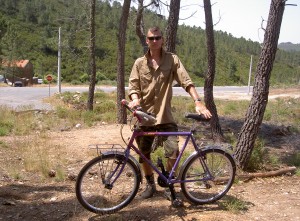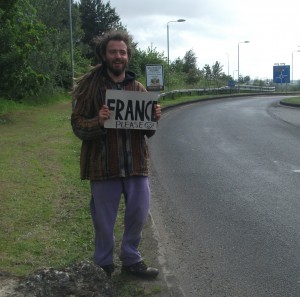This is part of a series of posts where we ask one of our volunteers or visitors to say a few words. Rosie joined us for a Permaculture Design Course and stayed on as one of the testers for our new Practical Self-Reliance Experience. Here, Rosie describes her journey to Casalinho and provides lots of useful links for those who wish to avoid flying.

I wanted to try and avoid travelling by plane on my journey to Casalinho. Although this would have been the quicker and potentially cheaper option, for me it felt slightly hypocritical to use such an unsustainable means of transport in order to get to a destination where one of my main goals was to learn about and experience a more sustainable way of living. Here is a neat little article which explains why trying to cut down on your air travel is worth while. However, sometimes flying seems unavoidable. If this is the case you may want to consider trying to repair some of the damage that your air travel will cause, sometimes called carbon offsetting. Casalinho has a tree fund which you can contribute to. Donations are used wholly towards purchasing additional trees for reforestation, nothing is lost to administration and ‘operating costs’.
(Note from Andrea: There is a donate button on the left hand sidebar. Click here to see some of the trees we are hoping to plant.)
Some of the other visitors to Casalinho during the time I was there hitch-hiked, and one even cycled, but I chose to arrange lifts in advance and use public buses.

For the first leg of my journey I travelled by car. My first destination was a festival so I went onto the Facebook page of the festival a few weeks before I was due to leave and enquired if anyone had spare space in their car. I also asked if anyone was travelling on after the festival towards Portugal or Spain. From this request I managed to get two different lifts. The first was going from England to the festival in France – and picked me up from my front door! We picked up a number of other people who were also in need of a lift from around Wales and Bristol and we all contributed money towards the ferry and the petrol. This meant the costs were kept down for all of us and we used less emissions per person by travelling with a full car. Result! The next lift I got was after the festival and was driving down through France to Spain. The driver was on her way to deliver a van she had bought in England to a friend in Spain. Again I helped to contribute petrol money to a journey that was going to be made anyway and everyone was happy! She dropped me off at the bus station in Zaragoza for the next leg of my trip. Although I arranged both these lifts through Facebook, there are a number of lift share websites you can use to find similar arrangements. www.blablacar.com is one based in Portugal.

From Zaragoza I had planned to get a bus to Badajoz, which is a city just on the border of Spain and Portugal. This bus would havetaken 9 hours and cost me €40. I managed to get into Zaragoza with my second lift with an hour or so to spare until my bus. I had decided not to pre-book my seat as I was worried that we may not make it there in time and didn’t want to risk paying twice. Unfortunately the bus was fully booked and there wasn’t another going straight from Zaragoza to Badajoz until the same time tomorrow. There was, however, a bus leaving for Madrid in just 5 minutes time. I knew from planning my journey before I left that there are buses which run from Madrid to Badajoz and so I jumped on, hoping I would be able to find my way when I got there. When I arrived in Madrid I found there was a connection to Badajoz leaving in the morning. These buses took around 4 hours for the first and 5 hours for the second and cost me €28 and €32 respectively. I had to wait overnight in Madrid for my connection to Badajoz so I lost half a days travel, but apart from that the journey went smoothly. If you can, my advice is to pre-book your ticket, particularly in the summer and other holiday periods. As I discovered, these long distance buses do sell out and there are sometimes only one a day so it can really mess up your plans.
Avanza buses are a Spanish service so only run through Spain. To find buses across Europe try Eurolines.
Once I got to Badajoz it was not too far for me to get to my final destination, however this was not Casalinho, but another smaller permaculture farm near Nisa, where I was staying for a few weeks before travelling on up to Casalinho. To get there I took a local bus from Badajoz to Elvas, crossing the border from Spain to Portugal. From Elvas I got a bus to Portalegre and from Portalegre to Nisa. This was relatively painless (and cheap – Portuguese local buses do not cost much) as each bus came within an hour of the previous arriving. However I think I may have gotten lucky with my timings as local buses can run infrequently depending on the bus. Rede-Expressos operate bus routes within Portugal.
For my journey from Nisa to Casalinho I got a bus from Nisa to Portalegre and then Portagre to Castelo Branco. From here I followed Andrea’s instructions and caught a bus from Castelo Branco to Fundao and then from Fundao to Sao Jorge da Beira.
Because I was travelling to Casalinho via my first host in Nisa I didn’t take the most direct route. If you also want to try and get here by land it may be easier to take a bus from Madrid to Coimbra as opposed to Badajoz. The bus from Madrid to Coimbra with Euroline cost €61 and takes 8 hours. From Coimbra there is a bus once a day to Unhais o Velho, which is a short taxi ride +/- €5 to the farm. Alternatively the bus from Madrid to Porto goes via Guarda and there is a bus that runs from Guarda to Fundao (then Fundao to Sao Jorge da Beira).
Travelling by train is also a good option when travelling over land. It is quicker than the buses and arguably more comfortable (you can catch night trains with beds in if you are going a long way). There is a company called Rail Europe who run trains across Europe. Their website can be a little tricky to use as you need to know all of your different changes so you can search for the timetables each leg at a time – as opposed to UK websites where you can enter your start and end destination and it will find you your changes. However, this difficulty is easily remedied as they have a super handy forum where you can explain the journey you want to make, start point end point, anywhere you want to go via etc and an employee from Rail Europe will get back to you with details of the train or trains you need. It also has an archive of all previous questions which is worth checking to see if someone has already made your trip. Alternatively, another visitor, Sharan, suggested looking at the Spanish Rail Service website where you can enter your departure and arrival destinations and receive back a suggested route.
Currently, RailEurope are advertising on their website London to Coimbra from £297 return.
I found this article which contains some tips on travelling to Portugal by train, but arguably the best article on travelling by train from London to Lisbon is probably this one from The Man in Seat 61.
If you are coming from England, Brittany Ferries run from Plymouth or Portsmouth to Spain, Santander or Bilbao. These are more direct routes than the ferry to Calais as you cut out France and a chunk of Spain too. There is a train route from Irun to Coimbra run by Rail Europe, however at the time of writing I was unable to find any trains using the search option on this route. This same route runs all the way from Coimbra to Hendaye in France. This is the train I will get when I leave Casalinho and it only costs €56.50.
Those links again –

Lift share website – www.blablacar.com
Portuguese cross country buses
Andrea’s local bus info from Lisbon or Porto
Travelling to Portugal by train tips article
The Man in Seat 61 travelling by train from London to Lisbon
Brittany Ferries (England to Spain)
